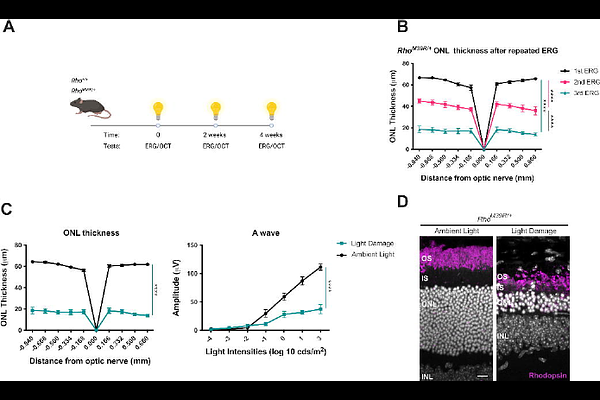Preventing light-induced toxicity in a new mouse model of rhodopsin sector retinitis pigmentosa

Preventing light-induced toxicity in a new mouse model of rhodopsin sector retinitis pigmentosa
Guarascio, R.; Ziaka, K.; Hau, K.; Piccolo, D.; Nieuwenhuis, S. E.; Bakoulina, A.; Asfahani, R.; Aguila, M.; Athanasiou, D.; Svara, D. S.; Li, Y.; Chen, R.; Cheetham, M. E.
AbstractRetinitis Pigmentosa (RP) is an inherited retinal dystrophy characterized by the progressive loss of rod photoreceptors. Sector RP is a form of RP, where degeneration originates in the inferior retina, mainly influenced by light exposure. Over 200 RHO variants are pathogenic and associated with autosomal dominant RP. RHOM39R is one of the most common RHO variants linked to sector RP in the UK. A knock-in (KI) mouse model expressing RhoM39R was generated and characterized to investigate the mechanisms of degeneration associated with this variant and explore novel therapeutic strategies for rhodopsin sector RP. Under ambient light, RhoM39R/+ KI mice exhibited impaired retinal function by ERG, with some defects in OS ultrastructure, but retained normal outer nuclear layer (ONL) thickness. Repeated exposure to bright light led to photoreceptor loss. In contrast, RhoM39R/M39R KI mice in ambient light displayed severe retinal dysfunction, ONL thinning, and grossly abnormal OS ultra structure. In homozygous mice, a single bright light exposure significantly reduced ONL thickness within 48 h. The rescue of these models was achieved through reduced light exposure and pharmacological intervention. Rearing in dim red light (red cage condition) restored ERG responses in RhoM39R/+ KI mice and improved ONL thickness in RhoM39R/M39R KI mice. Transcriptomic analysis in RhoM39R/M39R KI mice revealed upregulation of Sphingosine 1-P Receptor (S1PR) transcripts. Treatment with the S1PR agonist Fingolimod (FTY720) before bright light exposure significantly reduced degeneration, demonstrating a protective effect in both heterozygous and homozygous models and suggesting potential a therapeutic approach for sector RP patients.